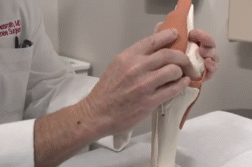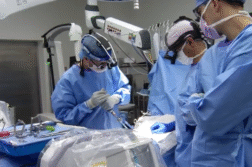LOS ANGELES, Calif. (Ivanhoe Newswire)— Augmented reality: it could be the future of spine surgery.
Unlike virtual reality that transports a person into another place, augmented reality is focused on what’s happening right in front of your eyes. AR, as it’s called, is giving surgeons x-ray vision.
With every press, and pull, and kick, Helen Joline is one step closer to getting back to normal. Even driving represents a big win for her. A few months ago, Helen couldn’t even do this. Diagnosed with osteoarthritis, her back pain was becoming unbearable.
“The joints just wear out and then bone spurs occur in those joints causing further problems, cartilage disappears,” Helen Joline told Ivanhoe.
Helen underwent a spinal fusion with augmented reality technology.
Her doctor, orthopedic surgeon Todd Allen, is one of the first to use this on spines. This is what the surgeon sees, a view from the top and side. The patient’s CT scan is superimposed.
Without augmented reality, surgeons rely on x-rays and CT images. They are looking at screens, not the patients. The difference: smaller incisions, less blood loss, less tissue dissection, lower risks from complications, and the potential for a faster recovery.
Helen Joline exclaimed, “I didn’t realize how bad I was feeling until I felt great.”
Just a few months after surgery and Helen is ready to go!
“I’m feeling very strong now. My core and my back is feeling strong,” Helen shared.
Strong enough to maybe even climb mountains in the future.
Dr. Allen believes augmented reality will be critical in teaching residents on how to perform these very technical spine surgeries, allowing future surgeons to see the spine as well as the trajectory of the instruments within the spine in real time, something new doctors had not been able to see before.
Contributors to this news report include: Marsha Lewis, Producer; Roque Correa, Videographer; Roque Correa, Editor.
To receive a free weekly e-mail on medical breakthroughs from Ivanhoe, sign up at: http://www.ivanhoe.com/ftk
Source:
MEDICAL BREAKTHROUGHS
RESEARCH SUMMARY
TOPIC: AUGMENTED REALITY: GPS FOR SPINE SURGERY
REPORT: MB #4944
AUGMENTED REALITY SPINE SURGERY BACKGROUND: The spine offers the body stability and strength, the vertebrae also protect the spine, so major issues with the spine can require surgery. Surgery is usually the last resort when working with the spine; however, there are benefits to spinal surgery. Depending on the severity of the procedure, you can move around better, be more physically fit, improve your mood due to less pain, take less pain medicine and you can go back to work and be more productive at work. Risks for spinal surgery include a reaction to anesthesia or other drugs, bleeding, infection, blood clots in your legs or lungs, a heart attack or stroke, a herniated disk, and nerve damage, which can lead to weakness, paralysis, pain, sexual dysfunction, or loss of bowel or bladder control.
(Source: https://www.webmd.com/back-pain/back-surgery-types)
AUGMENTED REALITY SPINE SURGERY DIAGNOSIS: There are different types of spinal injuries that require surgery. Lumbar decompression surgery for spinal stenosis is performed to correct a spinal canal that has become too narrow. Lumbar discectomy is a surgery involving an injured disc in the patient’s lower back region. Herniated disc surgery is performed to repair a herniated disc by removing part or all of the disc. Spinal fusion surgery connects two adjacent vertebrae in order to stop them from moving against each other. Before surgery, minimally invasive methods are attempted to address the patient’s pain or debilitating issues. If pain continues, an orthopedist may perform minimally invasive spine surgery.
(Source: https://www.oaidocs.com/2019/10/11/different-types-of-spine-surgery/)
AUGMENTED REALITY SPINE SURGERY NEW TECHNOLOGY: Augmented reality is a new technology in spinal surgery. The process consists of a headset with a see-through eye display that projects images of the patient’s internal anatomy based on their CT scans over their open surgical area. This essentially gives the surgeons x-ray vision in real time. Augmented reality has also been used to train medical students on surgeries like blood clot removals, or penis implant surgeries. However, adapting the technology from training to regular use has taken longer. This technology also allows the surgeons to be able to look at the CT scans and the patient without having to look away at a separate screen.
FOR MORE INFORMATION ON THIS REPORT, PLEASE CONTACT:
HEATHER BUSCHMAN
858-531-5620
If this story or any other Ivanhoe story has impacted your life or prompted you or someone you know to seek or change treatments, please let us know by contacting Marjorie Bekaert Thomas at mthomas@ivanhoe.com




